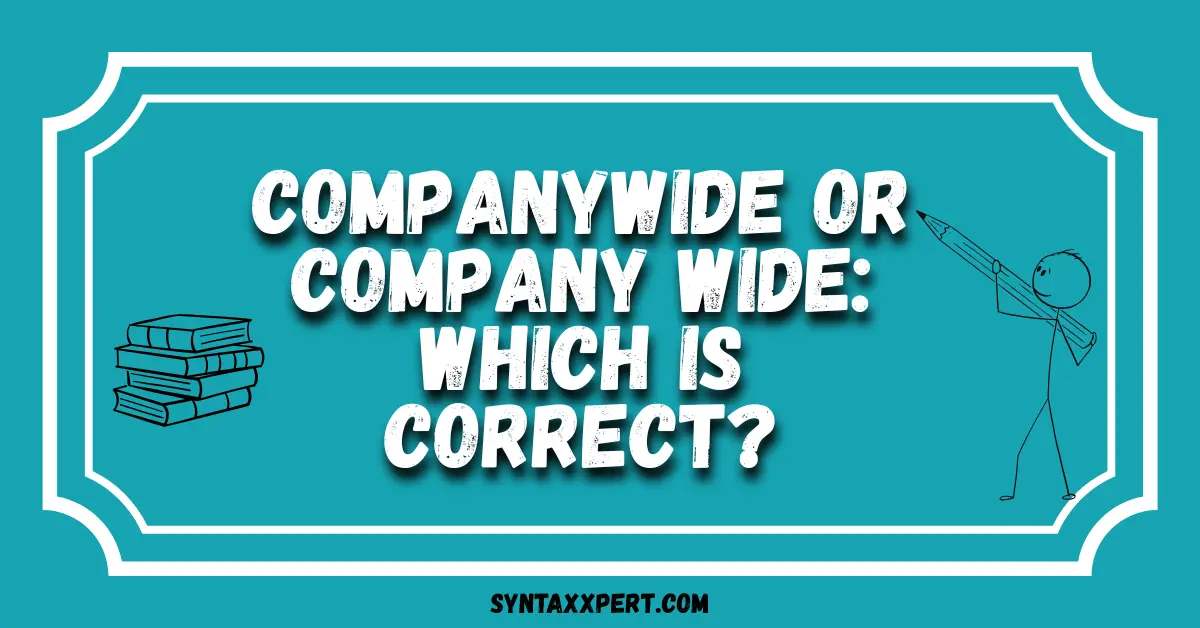Words carry weight in professional writing. A small detail like whether to use company wide with a hyphen or companywide as one word can change how polished your communication feels. In business, academic, or online content, clarity matters just as much as accuracy.
The debate around company wide vs companywide often confuses writers. Both forms appear in emails, corporate policies, and even style guides, but not all are equally correct in every situation. This article breaks down the meaning, grammar rules, style preferences, and business applications, so you’ll know exactly which version to use and why.
What Does Company Wide / Companywide Mean?
At its core, both company wide and companywide mean something that applies to the entire company. Whether it’s a company wide policy, a companywide initiative, or a companywide change, the phrase signals that every department, employee, or office is included.
Think of it as the corporate equivalent of “everyone on board.” If a CEO announces a companywide rollout, no team is left out—it’s for all staff, across all divisions.
Company Wide vs Companywide: Key Differences
Although the meaning is the same, grammar rules dictate when one form is preferred. Here’s a quick comparison:
| Usage | Correct Form | Example |
| Before a noun (compound adjective) | company wide | The company-wide policy improved communication. |
| After a verb / standalone | companywide | The new system was adopted companywide. |
| Two separate words | ❌ Incorrect | ❌ “Company wide policy” |
👉 Quick tip: “Company wide” as two words is never correct. Stick with company wide (hyphenated) or companywide (one word).
Grammar and Hyphenation Rules
When to Use Company Wide (Hyphenated)
Grammar experts recommend using the hyphenated form when it appears before a noun. This makes it a compound adjective. For example:
- “The CEO introduced a company wide strategy.”
- “We rolled out a company-wide survey.”
Here, the hyphen prevents confusion and keeps the meaning clear.
When to Use Companywide (One Word)
When the word follows a verb or stands alone, companywide (without the hyphen) is often preferred. Examples include:
- “The new guidelines apply companywide.”
- “Our changes were effective companywide.”
Modern dictionaries increasingly accept this form, especially in digital and informal contexts.
Why “Company Wide” (Two Words) Is Incorrect
Writing company wide as two words is grammatically wrong. English rules treat this as a broken compound—similar to writing time consuming instead of time-consuming. It weakens clarity and looks unprofessional.
Style Guide Recommendations
Different style guides weigh in differently on the company wide vs companywide debate:
- AP Style: Traditionally recommends the hyphen (company-wide) when used before a noun.
- Chicago Manual of Style: Accepts simplification trends, leaning toward companywide.
- Oxford English Dictionary: Lists both but highlights growing acceptance of companywide.
- Merriam-Webster: Includes companywide as one word.
📌 Best practice: Use company-wide before nouns in formal writing, but note that companywide is widely accepted across modern platforms.
Regional & Contextual Usage
- American English: Leans toward companywide in modern corporate writing.
- British English: Still favors the hyphenated company-wide in formal documents.
- Formal contexts: Hyphenation is safer, especially in contracts, policies, and academic papers.
- Informal contexts: Non-hyphenated companywide works fine in emails, blogs, or internal notes.
Language evolves, and hyphens tend to disappear as compounds become common. Companywide is trending upward in acceptance.
Examples of Correct Usage in Sentences
Company Wide (hyphenated):
- The HR team announced a company wide policy on remote work.
- A company wide meeting will take place next Monday.
- New cybersecurity measures were added as a company wide initiative.
Companywide (one word):
- The software update rolled out companywide within a week.
- The training program was successful companywide.
- Employees enjoyed benefits that applied companywide.
Incorrect (two words):
- ❌ The manager announced a company wide rule. ✅ Corrected: The manager announced a company wide rule.
Common Mistakes to Avoid
- ❌ Writing company wide as two separate words.
- ❌ Switching between company wide and companywide in the same document (lack of consistency).
- ❌ Overusing hyphens (e.g., company–wide).
- ❌ Ignoring audience: A legal contract requires more formality than a Slack message.
Business Applications & Use Cases
Company Wide Policy Example
“Our HR team introduced a company wide policy to ensure equal opportunities for all employees.”
Companywide Email Announcement Example
“The IT department sent a companywide email announcing the upcoming system upgrade.”
Companywide Rollout Example
“The new payroll system was implemented companywide, ensuring consistency across all offices.”
Adding real-world business examples makes the rule more practical and shows its professional relevance.
Related & Alternative Terms
Sometimes, companywide isn’t the only choice. Alternatives include:
- Organization-wide — used for nonprofits or broader institutions.
- Enterprise-wide — common in large corporations or IT rollouts.
- Firmwide — used in law firms and financial services.
- Industry-wide — when changes apply across an entire sector.
Each has its niche, but all follow the same hyphenation rules.
SEO Writing Tip: Which Form Works Best Online?
Search engines recognize both company wide and companywide. To optimize your content:
- Use company wide or companywide in the title and H1.
- Include both forms naturally in body text.
- Avoid “company wide.”
- Stay consistent within a single document to maintain professionalism.
Quick Answer
Quick Answer: Both company wide and companywide mean “across the entire company.” Use company-wide as a compound adjective before a noun (e.g., company-wide policy), and companywide after verbs (e.g., The change was companywide).
FAQs
Is companywide one word?
Yes, companywide is one word, especially when used after verbs.
Is company wide hyphenated?
Yes, use company-wide with a hyphen when it comes before a noun.
Can you write company wide as two words?
No. “Company wide” (two words) is incorrect and should be avoided.
Which is more professional: company wide or companywide?
Company-wide feels more formal, while companywide works well in modern or digital contexts.
Does AP Style prefer company wide or companywide?
AP Style favors company-wide when used as a compound adjective.
Is there a difference in British vs American English?
Yes. American English leans toward companywide, while British English still prefers company-wide.
Should I use company wide in SEO writing?
Use both forms to capture search queries, but be consistent throughout your content.
Conclusion
Both company wide or companywide are correct, but grammar and context guide their use. Use the hyphenated form as an adjective before nouns, and use the single word in less formal or standalone contexts. Never use “company wide” as two words.
By understanding the rules, following style guides, and applying consistency, your writing will look professional and SEO-friendly. Whether you’re drafting a policy, an announcement, or a blog, choosing the right form shows attention to detail across your communication—companywide.

I’m Luna Hazel, a grammar expert here to help you master the art of clear, confident writing. Let’s make every word count!

